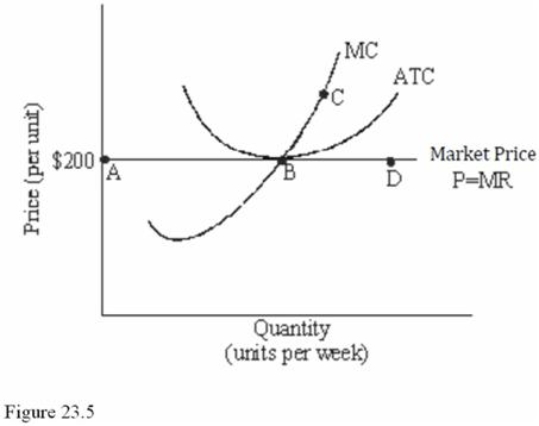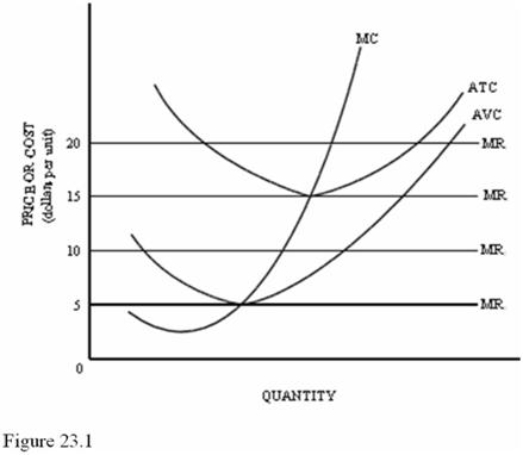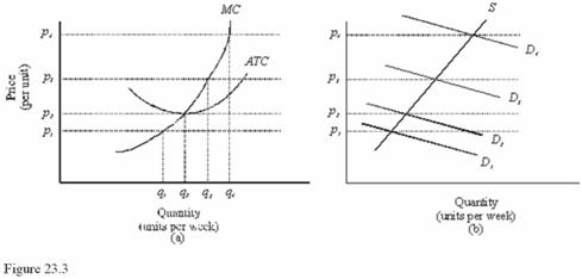A) Firms exit from the industry, driving up the market price.
B) Firms exit from the industry, driving down the market price.
C) No change in the number of firms in the industry and no change in the market price.
D) Firms enter the industry, driving down the market price.
Correct Answer

verified
Correct Answer
verified
Multiple Choice
If the products of two firms are homogeneous, then they
A) Are perfect substitutes.
B) Differ from each other.
C) Must be used together.
D) Are costless to produce.
Correct Answer

verified
A
Correct Answer
verified
Multiple Choice
The market supply curve in a perfectly competitive market is usually
A) Downward-sloping.
B) Horizontal.
C) Vertical.
D) Upward-sloping.
Correct Answer

verified
Correct Answer
verified
Multiple Choice
 Refer to Figure 23.5 for a perfectly competitive firm.Which of the following is not true for this firm at a price of $200?
Refer to Figure 23.5 for a perfectly competitive firm.Which of the following is not true for this firm at a price of $200?
A) The firm is using the fewest resources possible to produce each unit of output.
B) The firm is practicing marginal cost pricing.
C) The price is a reflection of the highest-valued good that could have been produced with the resources the firm used for the last unit it produced.
D) The firm should leave this market in an effort to earn economic profits.
Correct Answer

verified
Correct Answer
verified
Multiple Choice
The equilibrium price in a competitive market
A) Ensures that anyone who wants the good can get it.
B) Equates the demand for goods with the supply of goods.
C) Remains unchanged forever.
D) Remains unchanged only if demand doesn't change.
Correct Answer

verified
Correct Answer
verified
Multiple Choice
If price is below the long-run competitive equilibrium level, there will be
A) Greater demand.
B) Positive economic profits.
C) Greater output.
D) Exit of firms from the market.
Correct Answer

verified
Correct Answer
verified
True/False
Perfectly competitive markets are responsive to the demand of consumers.
Correct Answer

verified
Correct Answer
verified
Multiple Choice
A perfectly competitive market results in efficiency because
A) Price is driven down to minimum ATC.
B) Price rises high enough to equal marginal cost.
C) Zero economic profit is achieved.
D) MC < P.
Correct Answer

verified
Correct Answer
verified
Multiple Choice
The exit of firms from a market, ceteris paribus,
A) Shifts the market supply curve to the right.
B) Reduces the economic losses of remaining firms in the market.
C) Increases the equilibrium output in the market.
D) Shifts the market demand curve to the left.
Correct Answer

verified
Correct Answer
verified
Multiple Choice
If two products are homogeneous, then they
A) Are identical.
B) Differ from each other.
C) Must be used together.
D) Are similar to each other.
Correct Answer

verified
Correct Answer
verified
Multiple Choice
One In the News article "IBM Forced to Halt PCjr Output Next Month" indicates all of the following except:
A) Competitive pressure forced IBM to discontinue a particular PC model
B) IBM pushed the price down to no avail
C) IBM attempted to price below average total cost
D) IBM launched the product with a $40 million dollar advertising campaign
Correct Answer

verified
Correct Answer
verified
True/False
Patents are a barrier to entry.
Correct Answer

verified
Correct Answer
verified
Multiple Choice
 Refer to Figure 23.1 for a perfectly competitive firm.In the long run, this firm would stay in this market only if the market price was equal to or higher than
Refer to Figure 23.1 for a perfectly competitive firm.In the long run, this firm would stay in this market only if the market price was equal to or higher than
A) $5.
B) $10.
C) $15.
D) $20.
Correct Answer

verified
C
Correct Answer
verified
Multiple Choice
A competitive market creates strong pressure for technological innovation that
A) Allows the firm to raise the price of its product.
B) Provides the firm with more market power.
C) Shifts the firm's demand curve to the right.
D) Shifts the supply curve to the right.
Correct Answer

verified
Correct Answer
verified
Multiple Choice
If a firm finds that its marginal cost is greater than its price, it
A) Should reduce production.
B) Is maximizing its profit.
C) Should increase production.
D) Is maximizing its total revenue.
Correct Answer

verified
Correct Answer
verified
Multiple Choice
 In Figure 23.3, diagram "a" presents the cost curves that are relevant to a firm's production decision, and diagram "b" shows the market demand and supply curves for the market.Use both diagrams to answer the following question: In Figure 23.3, if market demand is at D1, the firm should
In Figure 23.3, diagram "a" presents the cost curves that are relevant to a firm's production decision, and diagram "b" shows the market demand and supply curves for the market.Use both diagrams to answer the following question: In Figure 23.3, if market demand is at D1, the firm should
A) Leave the market.
B) Produce q1.
C) Shut down.
D) Do any of the above depending on the position of the AVC and the length of the time period.
Correct Answer

verified
Correct Answer
verified
Multiple Choice
Technological improvements cause
A) New firms to enter but existing firms to continue producing their old output levels.
B) Some firms to exit but the remaining firms to produce more output.
C) Existing firms to produce more output.
D) Existing firms to continue producing their old output levels but to lower the price of the products.
Correct Answer

verified
Correct Answer
verified
Multiple Choice
In which of the following cases would entry and exit cease?
A) P > short-run ATC.
B) P = long-run ATC.
C) P > long-run ATC.
D) P < long-run ATC.
Correct Answer

verified
Correct Answer
verified
True/False
Market supply is the horizontal sum of the individual MC curves above the AVC in a perfectly competitive market.
Correct Answer

verified
Correct Answer
verified
Multiple Choice
In a competitive market,
A) Buyers don't have market power but sellers do.
B) Sellers don't have market power but buyers do.
C) Neither buyers nor sellers have market power.
D) Buyers and sellers both have market power.
Correct Answer

verified
C
Correct Answer
verified
Showing 1 - 20 of 151
Related Exams